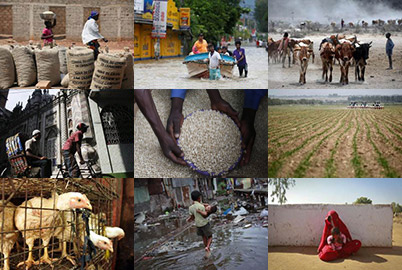Water levels in Sindh are not receding, preventing many from going home - UN OCHA official
NEW DELHI (AlertNet) – One million flood-hit Pakistanis still living in camps and makeshift shelters in the south, are in desperate need of basic lifesaving aid, four months after one of the biggest humanitarian crises in recent times, a senior U.N. official said.
The floods which started in July, decimated entire villages from the far north to the deep south, disrupting the lives of more than 18 million people in a disaster aid workers say was bigger than the 2004 tsunami or January’s earthquake in Haiti.
But while water levels have receded in the northern parts of the country and many of those uprooted are returning home, the head of the U.N. office responsible for emergencies in Pakistan said lifesaving aid is still urgently required in the south.
“We have a protracted humanitarian crisis in the south where we still have one million people displaced because of flooding in the province of Sindh,” Manuel Bessler, head of the U.N. Office for the Coordination of Humanitarian Affairs (OCHA) in Pakistan, told AlertNet in an interview.
“The basic survival items of food, water and sanitation, shelter and healthcare are urgently required.”
WATER LEVELS
The floods, sparked by unusually heavy monsoon rains, caused Pakistan's mighty Indus river to burst its banks, inundating one-fifth of the country and forcing millions to flee.
Hundreds of thousands of acres of crops have been destroyed and infrastructure such as roads, schools and bridges have been damaged in the provinces of Khyber Pakhtunkhwa and Baluchistan in the north, and Punjab and Sindh in the south.
Bessler said water levels in Sindh are not receding -- preventing many from going home.
“The water table is very high so little water can be absorbed into the ground and there is also a layer of sand and silt which is blocking absorption,” he said.
“The only way to get rid of the water is through evaporation and since we are now in the winter season ... there is little heat available to facilitate evaporation.”
He said it was likely that water levels would remain in some parts of Sindh until spring which starts in late February. It is estimated that hundreds of thousands of acres in the province are still submerged.
FUNDING SHORTFALL
The United Nations says it needs $1.9 billion to provide displaced populations with basic relief items as well as help those returning to repair their homes and generate some income.
But Bessler said donors have only contributed about 49 percent of the funds required and more is urgently needed -- especially for shelter and health services for the 500,000 people who are living in makeshift settlements.
“Shelter is a key concern as about half of the displaced in Sindh are living in ad hoc settlements close to the dirty, polluted water which has flooded their homes. They just have a plastic sheet to cover them and very poor sanitation,” he said.
“We have food to last us for another month or so, but if we don’t get more funds soon, we may have to cut food rations, replace certain food items or even limit food distribution.”
The U.N.’s emergency relief coordinator, Valerie Amos, visited Pakistan’s flood-hit areas last week to highlight the ongoing crisis and lobby donors.
Bessler said the crisis is likely to top the agenda at a conference on Pakistan in Abu Dhabi in January, and that hopefully the meeting would raise more aid from the international community.
Our Standards: The Thomson Reuters Trust Principles.

